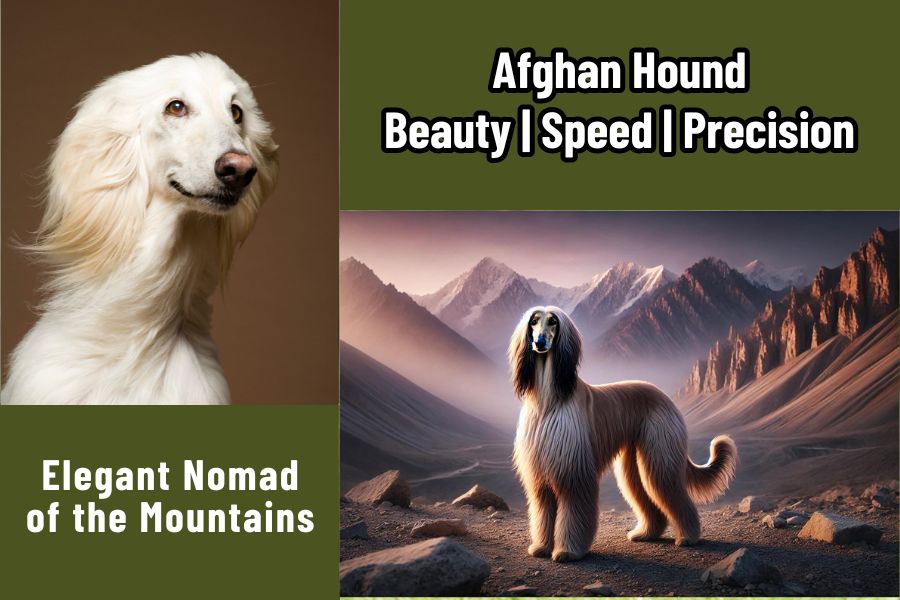Afghan Hound: Discover their rich history, glorious physical traits, training tips, and how to choose and care for this elegant nomad of the Mountains.
Introduction
Picture a sleek, elegant hound gliding effortlessly across the rugged terrain, its silky coat flowing like a regal cloak in the wind. The Afghan Hound, with its striking appearance and swift agility, is not just a visual marvel; it’s a breed steeped in rich history and unmatched grace. Known for their keen hunting instincts and royal demeanor, Afghan Hounds captivate hearts and minds alike.
Whether you’re a hunting enthusiast looking for a loyal and agile companion, a dog lover intrigued by the breed’s storied past, or someone seeking a beautiful, unique pet, this post is crafted just for you. Join us as we delve into the world of the Afghan Hound.
Afghan Hound Origin and History
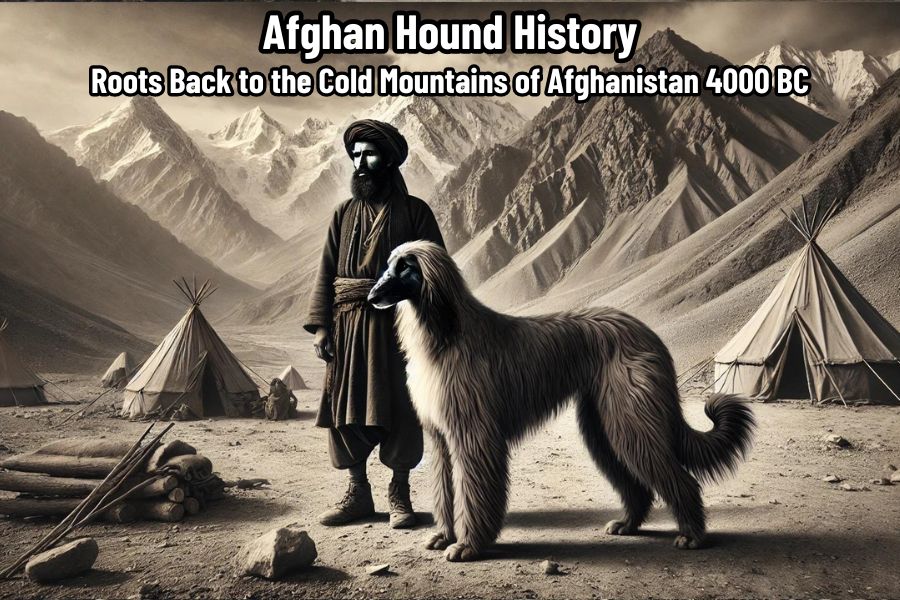
The Afghan Hound’s majestic presence is a testament to its ancient and storied lineage. This breed’s history is as rich and captivating as its luxurious coat, offering a glimpse into a time when these dogs roamed the rugged mountains and vast deserts of Central Asia. Let’s explore the fascinating origins and evolution of this remarkable breed.
Ancestors
The Afghan Hound’s origins trace back to the cold mountains of Afghanistan, where it is is locally known as Sag-e Tāzī, or Tāžī Spay. It is also referred to by several other names, including Tāzī, Balkh Hound, Baluchi Hound, Barakzai Hound and Levrier Afghan. To keep it simple we’ll use Afghan Hound and Tāzī in this article.
Tāzī is believed to be one of the oldest domestic dog breeds, dating back to 4,000 BC. Developed by nomadic peoples in Afghanistan, Pakistan, and northern India, these hunting hounds were prized for their ability to hunt game across challenging mountainous terrain. Their keen sight, incredible speed, and unmatched endurance made them indispensable hunting companions, able to pursue and capture prey with remarkable efficiency.
Evolution
The history of the Afghan Hound (Tāzī) is marked by the development of two main strains that contributed to the breed we know today. The Bell-Murray strain, also known as the “steppe” or “desert” type, consisted of dogs with lighter, less heavily coated fur, adapted to the arid environments. On the other hand, the Ghazni strain featured the more heavily coated mountain type dogs, suited for the colder, harsher climates of the mountains.
Over time, these two strains were interbred, blending their unique characteristics into the modern Afghan Hound breed. This integration culminated in the establishment of a new breed standard in 1948, which continues to define the Tāzī today. This standard encapsulates the breed’s elegant appearance, athletic build, and distinctive flowing coat, ensuring the preservation of its noble heritage.
Breed Status Today
Today, the Afghan Hound (Tāzī) enjoys a revered status among dog enthusiasts worldwide. In Afghanistan, the breed is still used for hunting and remains a symbol of cultural heritage. It is less commonly seen due to the country’s changing socio-economic landscape. In the USA and other parts of the world, they are cherished both as a show dog and a beloved pet. While not as populous as some other breeds, the Tāzī’s unique appeal ensures its continued presence in dog shows and households alike.
According to recent estimates, there are thousands of Afghan Hounds across the USA and several thousand more worldwide. Their exquisite beauty and dignified demeanor make them a sought-after breed for dog lovers who appreciate their aristocratic charm and historical significance.
Kennel Clubs
The Afghan Hound (Tāzī) has garnered recognition from numerous prestigious kennel clubs around the globe. The American Kennel Club (AKC) recognized the breed in 1926, acknowledging its unique qualities and historical importance. Similarly, the United Kennel Club (UKC) in the USA and The Kennel Club (TKC) in the UK have embraced the Afghan Hound, with the TKC recognition dating back to 1926. In Canada, the Canadian Kennel Club (CKC) also recognizes this regal breed.
In addition to these major organizations, there are several specialized clubs dedicated to the breed’s preservation and promotion. These clubs play a crucial role in maintaining breed standards, supporting breeders, and fostering a community of Tāzī enthusiasts.
Afghan Hound In Action
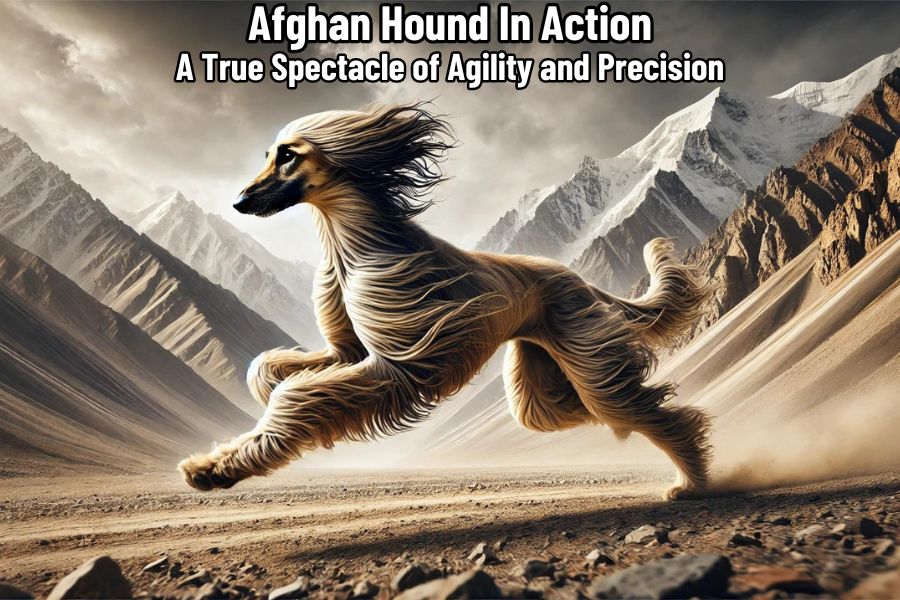
The Afghan Hound’s elegant appearance belies its formidable hunting prowess and remarkable agility. This section explores the dynamic roles these dogs play, from their historical roots as hunting companions to their modern-day activities.
Hunting Dog
The Afghan Hound (Tāzī) is classified as a sighthound, a breed known for its exceptional vision and speed. In their native Afghanistan, these dogs were revered for their hunting skills, capable of pursuing a wide variety of game across the rugged and mountainous terrain. Afghan sighthounds have been used to hunt leopards, gazelles, antelopes, rabbits, wild goats, jackals, foxes, and deer. Their keen sight, incredible speed, and ability to run silently make them exceptional hunters.
The hunting process for an Afghan Hound (Tāzī) is a spectacle of agility and precision. Adapted to rough country by their high, wide hipbones, the Tāzī spot their target from a considerable distance. Once the target is identified, the chase begins with an intensity that’s unmistakable. With their keen vision they lock onto the movement of prey, sometimes hundreds of yards away and in explosive strides, they swiftly close the distance. The pursuit is a combination of speed and strategy, with the Tāzī anticipating and matching the prey’s every move. Ultimately, they catch and hold or kill the prey until the hunter arrives, showcasing their remarkable hunting abilities.
Other Roles
In the USA and many other parts of the world, Afghan Hounds (Tāzī) are no longer primarily used for hunting. Instead, they have found new roles that capitalize on their natural grace and speed. One popular activity is lure coursing, a sport that simulates the hunt by having the dogs chase a mechanically operated lure across a field. The Tāzī excel in this sport, demonstrating their hunting instincts and agility.
The Tāzī, also celebrated as an Afghan beauty, make impressive show dogs. Their stunning appearance and dignified demeanor make them stars of the canine world. Their participation in dog shows allows them to showcase their beauty, poise, and breed standard characteristics, continuing to captivate audiences and judges alike.
Afghan Hound Physical Traits

The Afghan Hound (Tāzī) is a breed renowned for its striking appearance and athletic build, perfectly designed for speed and endurance. This section delves into the specific physical traits that define the breed.
Size (Length, Height, and Weight)
The Afghan Hound is a large, elegant breed with a graceful stature. Males typically stand between 27 to 29 inches at the shoulder, while females are slightly smaller, averaging 25 to 27 inches. In terms of weight, males usually range from 60 to 75 pounds, and females weigh between 50 to 65 pounds. Their length is proportionate to their height, contributing to their balanced and harmonious appearance.
Head and Muzzle
The Afghan Hound’s head is long and refined, with a prominent occiput and a slightly domed skull. The muzzle is also long and narrow, tapering gently to a black or liver-colored nose. This head structure gives the breed a noble and dignified expression, enhanced by its dark, almond-shaped eyes that exude an air of aloofness and intelligence. The ears are long and set low, covered in silky hair, framing the face beautifully.
Body Structure – Built for Speed
The Afghan Hound’s body is a marvel of natural engineering, built for speed and agility. The breed’s high, wide hipbones are particularly notable, allowing for an extended stride and powerful propulsion especially on mountainous terrain. Their deep chest provides ample lung capacity, essential for sustained running. The back is straight and strong, while the legs are long, straight, and well-muscled, contributing to their remarkable ability to cover ground swiftly and efficiently.
Coat Type and Colors
One of the most distinctive features of the Afghan Hound is its luxurious coat. The coat is long, silky, and fine in texture, flowing gracefully as the dog moves. It can come in a variety of colors, including black, brindle, blue, cream, red, and white, often with a black mask. Some Afghan Hounds also have a “domino” pattern, featuring a lighter color on the body with a darker overlay on the face and ears. Regular grooming is essential to maintain the beauty and health of their coat.
Keen Senses for Seeing Prey
As a sighthound, the Afghan Hound has exceptionally keen eyesight, crucial for spotting prey from a distance. Their large, expressive eyes are capable of detecting movement and detail, allowing them to track and pursue game with precision. This acute vision, combined with their speed, makes them formidable hunters.
Tail Structure and Purpose
The Afghan Hound’s tail is another distinctive feature, set low and carried in a ring or curve at the end. The tail is long and covered with a plume of hair, adding to the breed’s elegant appearance. During a hunt, the tail helps with balance and maneuverability, especially when navigating rough terrain.
Energy and Endurance
The Afghan Hound is a high-energy breed with remarkable endurance. Their larger heart and efficient respiratory system enable them to run long distances without tiring easily. This energy level requires regular exercise to keep them physically and mentally stimulated. Without adequate activity, they can become bored and restless.
Life Expectancy
The Afghan Hound typically has a life expectancy of 12 to 14 years. With proper care, nutrition, and regular veterinary check-ups, they can lead healthy, active lives well into their senior years.
Gestation Period and Litter Size
The gestation period for an Afghan Hound is approximately 63 days. Litter sizes can vary, but typically, the female will have between 6 to 8 puppies per litter. Responsible breeders should ensure that pregnant Afghan Hounds receive proper nutrition and care throughout their pregnancy to ensure the health of both the mother and her puppies.
Afghan Hound Behavioral Traits
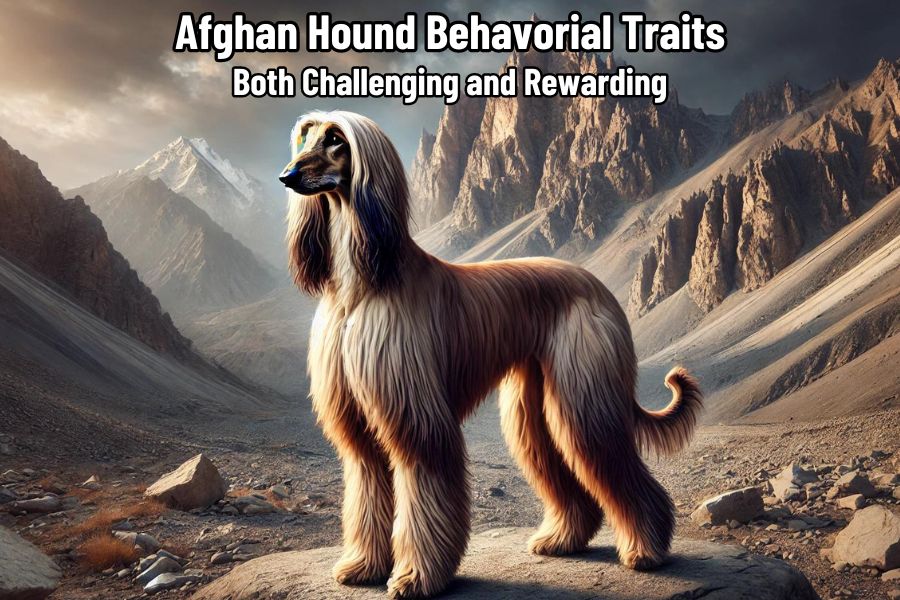
The Afghan Hound (Tāzī) is a breed known not only for its physical elegance but also for its unique and complex behavioral traits. These dogs exhibit a fascinating blend of characteristics that make them both challenging and rewarding companions.
Prey Drive
The Afghan Hound has a high prey drive, a trait deeply embedded in its genetic makeup as a sighthound. This drive is a result of their historical role as hunters in the rugged terrains of Afghanistan, where they pursued game such as leopards, gazelles, and rabbits. The (Tāzī) have an innate instinct to chase and capture, which can be both thrilling and demanding for their owners. Proper training and secure environments are essential to manage this natural instinct effectively.
Intelligence
While the Afghan Hound is often noted for its beauty, its intelligence can be misunderstood. In assessments of “working intelligence,” the Afghan Hound ranked last. This ranking does not reflect a lack of intelligence but rather highlights the breed’s independent nature. Tāzī are intelligent and capable but often choose to think for themselves, making them less inclined to follow commands compared to more obedient breeds. Their intelligence is evident in their ability to problem-solve and their remarkable memory, but it requires patience and creative training methods to harness effectively.
Versatile
Despite their regal appearance and natural hunting instincts, Afghan Hounds are versatile dogs that can adapt to various living conditions. Their adaptability makes them suitable for different types of households, from apartments to homes with large yards. They can thrive in both urban and rural environments as long as they receive adequate exercise and mental stimulation.
Temperament
The Afghan Hound is an independent dog breed, their temperament is a unique blend of independence and charm. They are known for their aloofness, often appearing distant or reserved with strangers. However, they can also be happy-go-lucky, displaying moments of playfulness and affection with their families. Tāzī can be stubborn, requiring consistent and patient training. Their independent streak can make them seem challenging, but it also adds to their allure as dignified and self-assured companions.
Loyal
One of the most endearing traits of the Afghan Hound is its loyalty. Once they bond with their owners, Tāzī are extremely loyal and devoted. This loyalty is not always immediately apparent due to their aloof nature, but it becomes evident through their protective and affectionate behavior towards those they trust. This deep bond makes them cherished members of the family.
Family Compatibility
Afghan Hounds can make good family pets, though their compatibility can vary. They often prefer to observe the activities of children and other pets rather than actively participate. This tendency to remain aloof does not mean they are unfriendly; rather, they enjoy watching the antics of their family from a distance. With proper socialization, Tāzī can coexist peacefully with children and other pets, adding an element of elegance to your household.
How to Choose the Right Afghan Hound Puppy?
Choosing the right Afghan Hound (Tāzī) puppy requires careful consideration and thorough research. This section will guide you through the essential steps to ensure you bring home a healthy, well-tempered Afghan Hound that suits your lifestyle.
Thoroughly Examine Breeders and Pedigree
When looking for an Afghan Hound puppy, start by identifying reputable breeders. A responsible breeder will have extensive knowledge about the breed and will prioritize the health and well-being of their dogs. Look for breeders who are members of recognized Afghan Hound clubs and who adhere to their ethical breeding standards.
Specific to the Afghan Hound breed, inquire about the puppy’s lineage and request to see health clearances for both parents. This breed can be prone to certain genetic conditions, so it’s crucial to ensure that the breeder tests for these issues, see list below under preventive care tips. Visiting the breeder’s facility can also provide insights into the living conditions and care the puppies receive, which can impact their overall health and temperament.
Evaluate Puppy Temperament and Behavior
The temperament of an Afghan Hound puppy is an important factor to consider. Tāzī are known for their independent and sometimes aloof nature, but puppies should still display curiosity and playfulness. Observe the puppies in their environment: a well-tempered Afghan puppy will interact positively with its littermates and show a balanced mix of energy and calmness.
Engage with the Afghan puppy to assess its responsiveness and sociability. While Tāzī can be reserved, especially with strangers, a good breeder will have started socialization early to ensure the puppies are well-adjusted. Look for signs of confidence and friendliness, as these traits will help the puppy integrate smoothly into your home.
Verify Health Status and Energy Levels
Ensuring the health of your Afghan puppy is paramount. Reputable breeders will provide health records for the puppy, including vaccinations and deworming. Additionally, they should offer a health guarantee, which typically includes a period during which you can have the puppy examined by your veterinarian.
Observe the Afghan puppy’s energy levels and overall vitality. Afghan Hounds are active and require regular exercise, so a healthy puppy will be lively and exhibit a good level of endurance. Check for clear eyes, clean ears, and a glossy coat, all indicators of good health. It’s also advisable to ask the breeder about the puppy’s diet and care regimen to ensure continuity when you bring your new companion home.
Caring for your Afghan Hound
Caring for an Afghan Hound (Tāzī) involves a blend of proper nutrition, regular exercise, grooming, preventive health care, and building a strong bond. Here are some key care tips to follow.
Nutrition Tips
Feeding an Afghan Hound requires attention to their specific dietary needs to support their active lifestyle and maintain their luxurious coat. A high-quality, balanced diet rich in protein is essential. Look for dog foods that list meat as the first ingredient, and avoid fillers like corn and soy.
Since Tāzī are active dogs, their diet should include adequate fats for energy and omega-3 fatty acids to promote skin and coat health. Splitting their daily food intake into two meals can help prevent gastric issues such as bloat. Always provide fresh water and consider supplements like glucosamine for joint health if recommended by your vet.
Routine Care Tips: Exercise and Grooming
Afghan Hounds are high-energy dogs that require regular exercise to stay healthy and happy. Aim for at least an hour of vigorous activity daily, including walks, runs, or playtime in a secure area or on leash. Their hunting instincts mean they enjoy chasing games and activities that challenge their agility and speed.
Do Afghan Hounds shed? The obvious answer is…Yes! Grooming a Tāzī is a significant commitment due to their long, silky coat. To help control shedding, brush them thoroughly at least two to three times a week. Brushing also helps prevent mats and tangles. Regular baths are necessary to keep their coat clean and shiny, but ensure you use dog-specific shampoo to avoid skin irritation. Pay special attention to their ears, as their long ear flaps can trap moisture and dirt, leading to infections. Regularly trim their nails and brush their teeth to maintain overall hygiene.
Preventive Care Tips
Regular veterinary check-ups are crucial for maintaining your Afghan Hound’s health. Ensure they receive vaccinations, heartworm prevention, and treatments for fleas and ticks. Afghan Hounds are prone to several health issues, so it’s important to monitor and check for the following:
- Gastric Dilatation-Volvulus (GDV): Also known as bloat, this is an emergency condition that can be fatal if not treated quickly. Symptoms include abdominal pain and swelling, drooling, retching without vomiting, and signs of distress like excessive panting, lip-licking, or restlessness.
- Hip and Elbow Dysplasia: These are genetic conditions that can lead to arthritis and mobility issues.
- Juvenile Cataracts: Eye problems that can affect their vision.
- Thyroiditis: An autoimmune disease that destroys the thyroid gland, leading to hypothyroidism.
- Laryngeal Paralysis: A condition affecting the larynx, causing breathing difficulties.
- Bleeding Disorders: Such as von Willebrand disease, which affects blood clotting.
- Sensitivity to Anesthesia and Cortisone: Afghan Hounds may react adversely to certain medications.
- Necrotic Myelopathy: A serious spinal condition.
- Panosteitis: An inflammatory bone condition causing pain and lameness.
Forging Relationship with your Afghan Hound
Building a strong relationship with your Afghan Hound is essential for their well-being. These dogs are known for their loyalty and form deep bonds with their owners. Spend quality time with them through regular play, training sessions, and cuddling. Positive reinforcement training methods work best, as Afghan Hounds respond well to kindness and patience.
Understanding their independent nature and respecting their occasional aloofness will help in forging a trusting and affectionate relationship. Engaging them in activities they enjoy will strengthen your bond.
Afghan Hound Training Tips
Training an Afghan Hound (Tāzī) can be a unique and challenging experience due to their independent and sometimes stubborn nature. Patience and consistency are key. Focusing on obedience training early on will set the foundation for a well-behaved dog. Tāzī respond best to positive reinforcement techniques and consistent training routines. Here are six key control commands to help you get started with training your Afghan Hound.
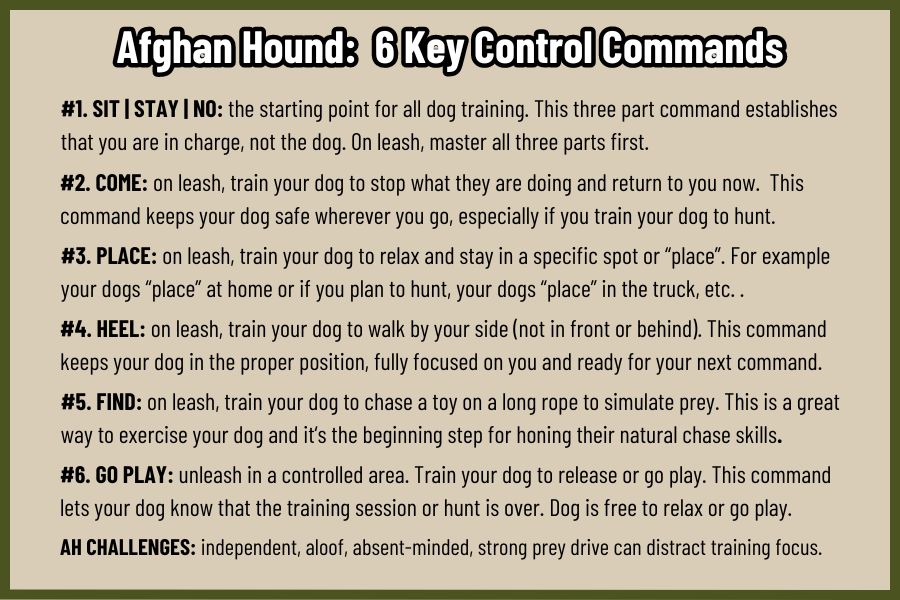
Stick To Your Training Plan
Consistency is crucial when training an Afghan Hound. These dogs thrive on routine and clear expectations. Sticking to a consistent training plan helps reinforce desired behaviors and reduces confusion. Use the same commands and training methods consistently to create a clear understanding of what is expected. Inconsistent training can lead to mixed signals, making it harder for your Tāzī to learn and adhere to the rules.
Why a Professional Trainer Might Be the Best Solution
Given their strong-willed nature, Afghan Hounds can be particularly challenging to train, especially for first-time dog owners. Professional trainers bring expertise, experience, and tailored methods that can significantly benefit the training process. These experts understand the breed’s specific needs and can provide proven and structured training methods.
If you find it difficult to commit the necessary time and provide consistent leadership and guidance, hiring a professional trainer might be the best solution for ensuring your Afghan Hound develops good habits and an obedient behavior.
Conclusion
The Afghan Hound (Tāzī) is an extraordinary breed, celebrated for its rich history, remarkable physical traits, and elegant beauty. From being a working sighthound to a blue-ribbon show dog, this breed embodies a perfect blend of energy, affection, and extreme loyalty to their owners.
Whether you’re looking for a show dog, a hunting companion, or an all-around athletic dog, the Tāzī stands out as an exceptional choice. Their unique combination of grace, intelligence, and independence makes them truly special. If you want to learn more about other masters of sight and speed, check out our post on [sighthounds].
FAQs: Afghan Hound
Can Afghan Hounds Be Aggressive?
Afghan Hounds are generally not aggressive. They are known for their aloof and independent nature, which can sometimes be mistaken for aggression. However, they are typically gentle and reserved, especially around their family. Socialization from an early age is important to ensure they are well-adjusted and comfortable in various situations. While they may be wary of strangers, aggression is not a common trait in this breed.
Are Afghan Hounds High Maintenance?
Yes, Afghan Hounds (Tāzī) are considered high maintenance dogs, primarily due to their grooming needs. Their long, silky coat requires regular brushing to prevent tangles and mats. They also need regular baths to keep their coat clean and shiny. In addition to grooming, the Tāzī requires a significant amount of exercise to keep them physically and mentally stimulated. Their high energy levels and independent nature mean they need a dedicated owner who can commit time and effort to their care.
Do Afghan Hounds Bark a Lot?
Afghan Hounds are not known to be excessive barkers. They tend to be relatively quiet dogs, barking only when necessary. However, like all dogs, they may bark to alert their owners of something unusual or if they are bored and seeking attention. Proper training and mental stimulation can help manage any excessive barking behavior.
Are Afghan Hounds Expensive?
The Afghan Hound cost can be quite expensive due to their rarity and the costs associated with their care. Purchasing a puppy from a reputable breeder can cost anywhere from $1,000 to $2,500, depending on the breeder’s reputation and the puppy’s pedigree. Additionally, the grooming, healthcare, and maintenance costs can add up, making Afghan Hounds a significant investment both initially and ongoing.
Are Afghan Hounds Good Off Leash?
Afghan Hounds are not typically recommended to be off-leash in unfenced areas. Their strong prey drive and incredible speed mean they can easily take off after small animals or interesting scents, making them difficult to recall. They excel in secure, fenced areas where they can safely run and play. Proper training and a strong bond with their owner can improve off-leash reliability, but caution is always advised.
What Are the Cons of Afghan Hounds?
- Standoffish by Nature: Afghan Hounds can be aloof and reserved, especially with strangers. This independent nature is part of their charm but can be a downside for those seeking a highly social dog.
- Challenging to Train: Their intelligence and independence can make them challenging to train. They require patience, consistency, and positive reinforcement techniques to succeed in obedience training.
- Need Extensive Grooming: Their beautiful coat requires significant grooming to keep it in top condition. Regular brushing and bathing are essential to prevent mats and tangles.
- Bores Easily, Needs Attention, Exercise: Afghan Hounds have high energy levels and can become bored easily if not given enough mental and physical stimulation. They need regular exercise and engagement to stay happy and healthy.
Resources: Afghan Hound
SPECIAL NOTE: “The information provided in this post is based on Google research and the Resource links listed below. While we try to keep the information for this post current, there are no representations expressed or implied, about the completeness, or accuracy of the information provided. Therefore all hunters should always verify current information from these resources along with other local and federal publications”.
Online Resources
- AKC – American Kennel Club
- TKC – The Kennel Club
- UKC – United Kennel Club
- CKC – Canadian Kennel Club
- AHCA – The Afghan Hound Club of America
- AHAUK – Afghan Hound Association (UK)
Best Books
- “The Afghan Hound: A Complete and Reliable Handbook” by Juliette Cunliffe
- This book provides a thorough overview of the breed, including history, care, training, and showing.
- “Afghan Hound (Comprehensive Owner’s Guide)” by Bryony Harcourt-Brown
- A detailed guide covering breed characteristics, training, health care, and grooming.
- “Afghan Hounds: Everything About Purchase, Care, Nutrition, Behavior, and Training” by Christina Williamson
- This book covers all aspects of the breed including ownership, from choosing a puppy to lifelong care and training.
- “The Afghan Hound: Myth or Reality” by Charles Harrisson
- An in-depth exploration of the breed’s history, characteristics, and the myths with rich illustrations and insights from experts.
- “Afghan Hounds: A Dog for All Seasons” by Joan Brearley
- A comprehensive guide that covers the breed’s history, care, and their roles in various activities, written by an experienced breeder and enthusiast.

